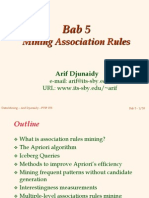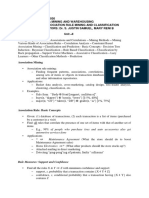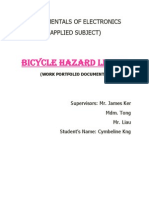FP Growth Algorithm
Uploaded by
Indrani MajumdarFP Growth Algorithm
Uploaded by
Indrani MajumdarMining Frequent Item sets without
Candidate Generation
Apriori with candidate generation is costly for two reasons:
1. It may need to generate a huge number of candidate sets.
For Example : if there are 104 frequent 1-itemsets, the Apriori
algorithm will need to generate more than 107 candidate 2-itemsets.
2. It is costly to go over each transaction in the database to determine the
support of the candidate item sets
December 7, 2021 Data Mining: Concepts and Techniques 1
Mining Frequent Itemsets without
Candidate Generation
“Can we design a method that mines the complete set of frequent itemsets
without candidate generation?”
FP-growth (frequent-pattern growth,): adopts a divide-and-conquer strategy
as follows :
1. First, it compresses the database representing frequent items into a
frequent-pattern tree, or FP-tree
2. It then divides the compressed database into a set of conditional databases
,each associated with one frequent item and mines each such database
separately.
December 7, 2021 Data Mining: Concepts and Techniques 2
Mining Frequent Itemsets without
Candidate Generation
FP-growth : Example
We re-examine the mining of transaction database, D
December 7, 2021 Data Mining: Concepts and Techniques 3
Mining Frequent Itemsets without
Candidate Generation
FP-growth : Example
We re-examine the mining of transaction database, D
The first scan of the database is the same as Apriori. Let the min_sup = 2
Here the set of frequent items is sorted in the order of descending
support count. we have L ={{I2: 7}, {I1: 6}, {I3: 6}, {I4: 2}, {I5: 2}}
Sorted itemsets
We say that the
items are in L - order
December 7, 2021 Data Mining: Concepts and Techniques 4
Mining Frequent Itemsets without
Candidate Generation
FP-growth : Example (Constructing FP – tree)
December 7, 2021 Data Mining: Concepts and Techniques 5
Mining Frequent Itemsets without
Candidate Generation
FP-growth : Example (Constructing conditional databases)
Next FP-tree is mined as follows :
1. Starting with last item in table and constructing its conditional pattern
base : A “subdatabase” which consists of the set of prefix paths in the FP-tree co-
occurring with the suffix pattern
2. Construct conditional FP-tree
3. Frequent itemsets are found by the concatenation of the suffix pattern with the
frequent patterns generated from a conditional FP-tree
December 7, 2021 Data Mining: Concepts and Techniques 6
Mining Frequent Itemsets without
Candidate Generation
FP-growth : Example (Constructing conditional databases)
December 7, 2021 Data Mining: Concepts and Techniques 7
2. Example
You might also like
- A New Scheduler in xv6: Sumith (140050081) Shubham Goel (140050086)No ratings yetA New Scheduler in xv6: Sumith (140050081) Shubham Goel (140050086)4 pages
- Market Basket Analysis Using Improved FP-treeNo ratings yetMarket Basket Analysis Using Improved FP-tree4 pages
- UNIT-1 Introduction: Motivation: Why Data Mining?No ratings yetUNIT-1 Introduction: Motivation: Why Data Mining?86 pages
- It5003 - Data Warehousing and Data Mining-1No ratings yetIt5003 - Data Warehousing and Data Mining-15 pages
- A Comparative Analysis of NFA and Tree-Based Approach For Infrequent Itemset MiningNo ratings yetA Comparative Analysis of NFA and Tree-Based Approach For Infrequent Itemset Mining5 pages
- DFP-Growth: An Efficient Algorithm For Frequent Patterns in Dynamic Data MiningNo ratings yetDFP-Growth: An Efficient Algorithm For Frequent Patterns in Dynamic Data Mining5 pages
- Lecture 1-Introduction To Data Mining - MNo ratings yetLecture 1-Introduction To Data Mining - M38 pages
- The Data Explosion: Modern Computer Systems Are Accumulating Data at An Almost Unimaginable Rate and From ANo ratings yetThe Data Explosion: Modern Computer Systems Are Accumulating Data at An Almost Unimaginable Rate and From A14 pages
- A Hybrid Algorithm Using Apriori Growth and Fp-Split Tree For Web Usage MiningNo ratings yetA Hybrid Algorithm Using Apriori Growth and Fp-Split Tree For Web Usage Mining5 pages
- Predicting Missing Items in A Shopping Cart Using Apriori AlgorithmNo ratings yetPredicting Missing Items in A Shopping Cart Using Apriori Algorithm3 pages
- Data Mining Concepts and Techniques - Han, Kamber & PeiNo ratings yetData Mining Concepts and Techniques - Han, Kamber & Pei953 pages
- Data Mining: Concepts and Techniques: - Slides For Textbook - Chapter 6No ratings yetData Mining: Concepts and Techniques: - Slides For Textbook - Chapter 682 pages
- Difference Between Data Mining and Query Tools100% (1)Difference Between Data Mining and Query Tools6 pages
- Literature Review On Mining High Utility Itemset From Transactional DatabaseNo ratings yetLiterature Review On Mining High Utility Itemset From Transactional Database3 pages
- Analysis and Implementation of FP & Q-FP Tree With Minimum CPU Utilization in Association Rule MiningNo ratings yetAnalysis and Implementation of FP & Q-FP Tree With Minimum CPU Utilization in Association Rule Mining6 pages
- Department of Information Technology: Data Warehousing and Data Mining IT4204 3No ratings yetDepartment of Information Technology: Data Warehousing and Data Mining IT4204 360 pages
- April 25, 2019 Data Mining: Concepts and TechniquesNo ratings yetApril 25, 2019 Data Mining: Concepts and Techniques21 pages
- An Improved Approach of FP-Growth Tree For Frequent Itemset Mining Using Partition Projection and Parallel Projection TechniquesNo ratings yetAn Improved Approach of FP-Growth Tree For Frequent Itemset Mining Using Partition Projection and Parallel Projection Techniques6 pages
- (18-22) Hybrid Association Rule Mining Using AC TreeNo ratings yet(18-22) Hybrid Association Rule Mining Using AC Tree5 pages
- DATA MINING-Knowledge Discovery in DatabasesNo ratings yetDATA MINING-Knowledge Discovery in Databases6 pages
- CITS4243: Advanced Databases: Datta@csse - Uwa.edu - AuNo ratings yetCITS4243: Advanced Databases: Datta@csse - Uwa.edu - Au51 pages
- Chapter 1 - Introduction - : WWW - Cs.uiuc - Edu/ HanjNo ratings yetChapter 1 - Introduction - : WWW - Cs.uiuc - Edu/ Hanj52 pages
- Ncert Solutions Class 9 Math Chapter 13 Surface Area and VolumesNo ratings yetNcert Solutions Class 9 Math Chapter 13 Surface Area and Volumes97 pages
- [FREE PDF sample] CURRENT Diagnosis Treatment Gastroenterology Hepatology Endoscopy 1st Edition Norton Greenberger ebooksNo ratings yet[FREE PDF sample] CURRENT Diagnosis Treatment Gastroenterology Hepatology Endoscopy 1st Edition Norton Greenberger ebooks67 pages
- Smart TV Mainboard ZLS47HIS-V1 With Cannot Startup Problem SolvedNo ratings yetSmart TV Mainboard ZLS47HIS-V1 With Cannot Startup Problem Solved6 pages
- Cosine Rule (Law of Cosines) - Brilliant Math & Science WikiNo ratings yetCosine Rule (Law of Cosines) - Brilliant Math & Science Wiki7 pages
- Cutter Option: Installation InstructionsNo ratings yetCutter Option: Installation Instructions14 pages
- Experiment 5: # Touch File1.txt # LN - S File1.txt /home/tecmint/file1.txt (Create Symbolic Link)No ratings yetExperiment 5: # Touch File1.txt # LN - S File1.txt /home/tecmint/file1.txt (Create Symbolic Link)9 pages
- SSGC Test MCQS For Electrical and Electronics100% (1)SSGC Test MCQS For Electrical and Electronics5 pages
- Chapter 3_P1_MSI Logic Circuit (Decoder-Encoder)No ratings yetChapter 3_P1_MSI Logic Circuit (Decoder-Encoder)67 pages
- 3fe77621aaaafmzza - v1 - Isam r6.5 Customer Release Note100% (1)3fe77621aaaafmzza - v1 - Isam r6.5 Customer Release Note58 pages
- Quantum Field Theory A Diagrammatic Approach 1st Edition Ronald Kleiss pdf download100% (1)Quantum Field Theory A Diagrammatic Approach 1st Edition Ronald Kleiss pdf download34 pages
- The Mathematics of DNA Sturcture Mechanics and DynNo ratings yetThe Mathematics of DNA Sturcture Mechanics and Dyn29 pages
- Confining Reinforcement For High StrengtNo ratings yetConfining Reinforcement For High Strengt2 pages
- Bicycle Hazard Lights: Fundamentals of Electronics (Applied Subject)No ratings yetBicycle Hazard Lights: Fundamentals of Electronics (Applied Subject)33 pages
- A New Scheduler in xv6: Sumith (140050081) Shubham Goel (140050086)A New Scheduler in xv6: Sumith (140050081) Shubham Goel (140050086)
- A Comparative Analysis of NFA and Tree-Based Approach For Infrequent Itemset MiningA Comparative Analysis of NFA and Tree-Based Approach For Infrequent Itemset Mining
- DFP-Growth: An Efficient Algorithm For Frequent Patterns in Dynamic Data MiningDFP-Growth: An Efficient Algorithm For Frequent Patterns in Dynamic Data Mining
- The Data Explosion: Modern Computer Systems Are Accumulating Data at An Almost Unimaginable Rate and From AThe Data Explosion: Modern Computer Systems Are Accumulating Data at An Almost Unimaginable Rate and From A
- A Hybrid Algorithm Using Apriori Growth and Fp-Split Tree For Web Usage MiningA Hybrid Algorithm Using Apriori Growth and Fp-Split Tree For Web Usage Mining
- Predicting Missing Items in A Shopping Cart Using Apriori AlgorithmPredicting Missing Items in A Shopping Cart Using Apriori Algorithm
- Data Mining Concepts and Techniques - Han, Kamber & PeiData Mining Concepts and Techniques - Han, Kamber & Pei
- Data Mining: Concepts and Techniques: - Slides For Textbook - Chapter 6Data Mining: Concepts and Techniques: - Slides For Textbook - Chapter 6
- Literature Review On Mining High Utility Itemset From Transactional DatabaseLiterature Review On Mining High Utility Itemset From Transactional Database
- Analysis and Implementation of FP & Q-FP Tree With Minimum CPU Utilization in Association Rule MiningAnalysis and Implementation of FP & Q-FP Tree With Minimum CPU Utilization in Association Rule Mining
- Department of Information Technology: Data Warehousing and Data Mining IT4204 3Department of Information Technology: Data Warehousing and Data Mining IT4204 3
- April 25, 2019 Data Mining: Concepts and TechniquesApril 25, 2019 Data Mining: Concepts and Techniques
- An Improved Approach of FP-Growth Tree For Frequent Itemset Mining Using Partition Projection and Parallel Projection TechniquesAn Improved Approach of FP-Growth Tree For Frequent Itemset Mining Using Partition Projection and Parallel Projection Techniques
- (18-22) Hybrid Association Rule Mining Using AC Tree(18-22) Hybrid Association Rule Mining Using AC Tree
- CITS4243: Advanced Databases: Datta@csse - Uwa.edu - AuCITS4243: Advanced Databases: Datta@csse - Uwa.edu - Au
- Chapter 1 - Introduction - : WWW - Cs.uiuc - Edu/ HanjChapter 1 - Introduction - : WWW - Cs.uiuc - Edu/ Hanj
- Ncert Solutions Class 9 Math Chapter 13 Surface Area and VolumesNcert Solutions Class 9 Math Chapter 13 Surface Area and Volumes
- [FREE PDF sample] CURRENT Diagnosis Treatment Gastroenterology Hepatology Endoscopy 1st Edition Norton Greenberger ebooks[FREE PDF sample] CURRENT Diagnosis Treatment Gastroenterology Hepatology Endoscopy 1st Edition Norton Greenberger ebooks
- Smart TV Mainboard ZLS47HIS-V1 With Cannot Startup Problem SolvedSmart TV Mainboard ZLS47HIS-V1 With Cannot Startup Problem Solved
- Cosine Rule (Law of Cosines) - Brilliant Math & Science WikiCosine Rule (Law of Cosines) - Brilliant Math & Science Wiki
- Experiment 5: # Touch File1.txt # LN - S File1.txt /home/tecmint/file1.txt (Create Symbolic Link)Experiment 5: # Touch File1.txt # LN - S File1.txt /home/tecmint/file1.txt (Create Symbolic Link)
- 3fe77621aaaafmzza - v1 - Isam r6.5 Customer Release Note3fe77621aaaafmzza - v1 - Isam r6.5 Customer Release Note
- Quantum Field Theory A Diagrammatic Approach 1st Edition Ronald Kleiss pdf downloadQuantum Field Theory A Diagrammatic Approach 1st Edition Ronald Kleiss pdf download
- The Mathematics of DNA Sturcture Mechanics and DynThe Mathematics of DNA Sturcture Mechanics and Dyn
- Bicycle Hazard Lights: Fundamentals of Electronics (Applied Subject)Bicycle Hazard Lights: Fundamentals of Electronics (Applied Subject)

























































































